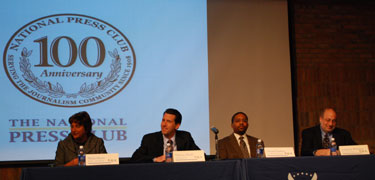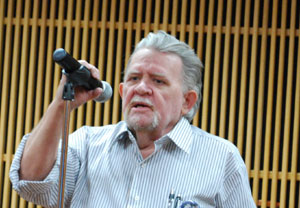The Future of Journalism
“I’ve never seen reporters so excited as when they’re talking about their Twitters,” remarked Gil Klein, moderator of a panel discussion Wednesday night at the Gerald R. Ford Library in Ann Arbor. The discussion was part of a nationwide tour of similar events hosted by the National Press Club as a part of the organization’s 100th anniversary. Klein, director of the National Press Club’s Centennial Forums, mentioned the micro-blogging platform Twitter in the current context of the tremendous period of innovation in the field of journalism.
But the consensus among panelists was that the raft of new technologies and platforms had actually become somewhat of an additional burden on reporters, which ultimately was not yet offering a return on the bottom line that would keep newsrooms fully staffed. Panelist Vincent Duffy, who has been the news director at Michigan Radio since May 2007, characterized the response from managers to innovative technology this way: “That’s great! Do that, too.”
As a result, said Duffy, what suffers is the reporting of news. From the perspective of a news director for a radio operation, Duffy said that for a particular segment that’s aired, (i) there’s a radio version, (ii) a web version, (iii) a printed version for the web, which has to be cleaned up to bring the spoken version to a written standard, and (iv) a web promo for the piece. And then, continued Duffy, radio news directors find themselves asking (v) do we have pictures? (vi) do we have enough pictures for a slideshow? (vii) do we have video? (viii) do we have a Twitter? (ix) do we have a blog post? What is sacrificed in this flurry of media, said Duffy, is what historically would have been attention by news directors and editors to the story itself: requests for additional background information, an additional source, an update.
Further, said Duffy, the vast mix of digital options meant that is was not obvious what the “media of record” was. This role has historically been played by newspapers. With the number of newspapers dwindling, Duffy said it wasn’t clear who might have the resources to cover important events like the Detroit city council meeting, the Ann Arbor city council meeting, and the Fowlerville library board.
In response to an audience question, Duffy said that in public radio, they were aware that there are plenty of people who don’t have access to computers or else simply prefer not to get their news from a computer screen. However, Duffy pointed out that people under 30 basically do not listen to public radio – median age for public radio listenership is 45. So for public radio, the web is a key to gaining new audience. The idea is to introduce the next generation to public radio via computers.
How to monetize the new audience that comes via the web is something the panelists agreed was a challenge that had not been met. Panelist Jonathan Wolman, who is editor and publisher of The Detroit News as well as publisher of its website, detnews.com, characterized it as a situation where the growth in revenues from web advertising was encouraging, but had not reached anywhere near the levels it would take to replace lost revenue from the print side of the equation. Comparing web to print, the ratio Wolman offered was 1:8. The advertisers, said Wolman, are as confused as anyone else.
But for her part, panelist Marla Drutz, vice president and general manager of WDIV-TV Detroit, seemed to suggest that if there’s a burden of technology that’s not accruing to the bottom line, then it’s self-imposed. The role of managers, she said, is to allocate resources to those activities that make bottom-line sense. She said that one of the main attractions for a television operation was weather information – even though the total amount of time devoted to weather in the course of a day might be a half hour’s worth of programming. This allowed the investment in extremely sophisticated and expensive equipment and could justify the hiring of a meteorologist. If no one is reading the blog, or following the Twitters, or watching the video, then don’t do it, she said. The metrics, she pointed out, are easily accessible.
In fact, the panelists all spoke of the standard place in their morning meetings of the metrics for analysis of web traffic on the various stories from the previous day. Panelist Omari Gardner, news editor for digital media at the Detroit Free Press, described “tailoring the product” based on the web traffic analysis.
Gardner also talked about the impact of buyout strategies in order to keep newspapers solvent. He said that it was typically the most experienced reporters (and most highly compensated) who were being ushered out with buyout offers, and that had the effect of removing an important piece of the system of mentorship. Older, more experienced members of the newsroom could no longer show the new folks the ropes.
The amount of time the panelists spent talking about financial viability and the measurement of success by audience prompted an audience member to wonder if they were more interested in protecting a free press or rather creating a sale-able product. The audience question alluded to the title of the panel discussion, which was “Protecting a Free Press while Journalism Is in Turmoil.” To that, Duffy said that historically the press had always been a business proposition and that the nature of that proposition hadn’t changed.
To be fair to the panelists’ focus on sale-ability of product and reporting the news with fewer resources, it was driven somewhat by the moderator’s questions. In fact, the first question at the beginning of the night concerned whether the panelists felt they had adequate resources to cover the story currently unfolding on the automobile industry. The panelists said they were ready and able to cover that story. But towards the end of the evening, a voice from the audience familiar to Chronicle readers questioned whether the press had been doing an adequate job covering the auto industry in the period leading up to the current crisis. Tom Partridge expressed his disappointment in the Michigan media for not providing more information about the Big Three’s business plans, pointing out that except for Chrysler, these are public companies.
In response to Partridge, Gardner said that reporters did the best they could, but that the auto companies were quite insular and that they had set up barriers and boundaries that made it difficult.
Partridge also asked the panelists to speculate on whether the election of Barack Obama would herald a new era of openness and freedom of the press. Duffy was skeptical. “They didn’t call him No-drama Obama for nothing,” he said.
The presidential allusion looped nicely back to the beginning of the evening, when Richard Ryan, retired chief Washington correspondent for The Detroit News, talked about his experience covering Gerald Ford. When Ford was announced as the pick for vice-president to replace Agnew, Ryan drove out to Ford’s house that night on the off chance that he might be able to talk to him. Ryan wound up talking to Ford sitting in a blue leather chair, with Susan sitting on the couch, Betty in the next room chatting with friends, and a dog and cat skittering around the house. Ford told him that on Tuesday, he was going back to Grand Rapids … for Red Flannel Day. And that, said Ryan, reflected that Ford was still the congressional representative from Michigan, not yet the vice president.
Klein, the moderator, had been keeping an eye on the time on account of the weather forecast for rain to start around 9 p.m. – perhaps he had visited Drutz’s website before the discussion started. And it did wrap up shortly after 9 p.m.







Dave,
I bet all the journalists on the panel would have given you and “A” on this article. Except I didn’t get my Twitter yet! Maybe I just don’t know how? :)
Stew
Stew,
The Ann Arbor Chronicle on Twitter is a2chronicle. You just need to “follow” that account to get our Tweets to start showing up.
We use it for Stopped. Watched. type items and for previews of upcoming stories, and the like.
Great job and you didn’t add any of my personal thoughts like how disappointed I was that they didn’t deal with the 1st Amendment, Freedom of Speech or threat to Democracy. It was their own lamenting that came across to me.
They sound like a lot of people today who have to work twice as hard to make a buck. Those were my thoughts about the evening – you do a great job of explaining what they said.
*Great Coverage!*